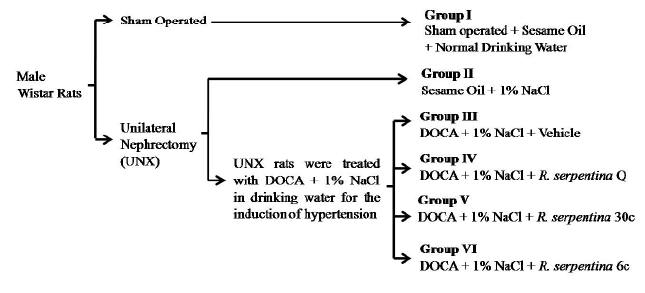
Scheme 1: Experimental design for the evaluation of antihypertensive effect of R. serpentina

Sandeep Kumar1 Jagneshwar Dandapat1 Gagan Bihari Nityanand Chainy*1 Akshaya Kumar Hat2 Laxmikanta Nanda2 Indramani Nath3
1Department of Biotechnology, Utkal University, Bhubaneswar, 751004, Odisha, India*Corresponding author: G.B.N. Chainy, UGC Emeritus Professor, Department of Biotechnology, Utkal University, Bhubaneswar, 751004, Odisha, India, Tel/Fax: 06742567390; E-mail: chainyg@gmail.com
In the present study, effects of homeopathic medicine Rauwolfia serpentina (Q, 30c and 6c) were investigated on blood pressure, heart rate, serum biochemical parameters, oxidative stress indices and expression levels of antioxidant defence enzymes in the kidney of deoxycorticosterone acetate (DOCA)-salt-induced hypertensive uninephrectomized male rats. Administration of R. serpentina to hypertensive rats resulted in reduction of systolic and diastolic blood pressure. Elevated serum sodium level in hypertensive rats were reduced in response to 30c and 6c potencies of the drug. Serum potassium level was decreased in response to Q and 30c, albeit its level was increased after administration of 6c potency of the medicine. Elevated serum levels of aspartate aminotransferase (AST) and lactate dehydrogenase (LDH) of hypertensive rats were lowered in response to various potencies of the medicine. Serum glucose level was decreased and creatinine level was increased in the hypertensive rats in response to 6c potency of the medicine. Increased levels of lipid peroxidation in the kidney of hypertensive rats were restored to control value in response to all potencies of the medicine. On the other hand, elevated protein carbonyl content in the post mitochondrial fraction (PMF) of the kidney in hypertensive rats was decreased in response to 30c. However, in mitochondrial fraction (MF) it was decreased in response to the potencies, Q and 30c. Transcript level of Superoxide dismutase1 (SOD1) in the study of hypertensive rats was elevated in response to the medicine without any alteration in the level of translated products, except in case of 6c potency, where it was reduced. The transcript level of SOD2 in the kidney of hypertensive rats was decreased in response to Q potency of the medicine but its translated products were decreased in response to 30c and 6c potencies. Though SOD activity was elevated in PMF of kidney in 6c treated group, its activity was decreased in MF in response to the medicine. Although catalase (CAT) mRNA level did not change in response to the medicine, its translated products were decreased in response to 30c and 6c potencies. Kidney CAT activity of the hypertensive rats was decreased in PMF in response to all potencies of the medicine but was increased in MF in response to Q potency only. Renal glutathione peroxidase (GPx) activity of the hypertensive rats was elevated in the MF after treatment with 30c and 6c potencies of the medicine without any change in its transcript level. Glutathione S-Transferase (GST) activity of the kidney was increased in PMF of 30c treatment group. Overall findings indicate that different potencies of homeopathy medicine R. serpentina have the efficacy to reduce systolic blood pressure in DOCA-salt-induced hypertensive rat and also modulates serum clinical parameters and renal antioxidant defenses.
Rauwolfia serpentine; DOCA; Hypertension; Blood pressure; Oxidative stress; Antioxidant
Hypertension, the most common cardiovascular disorder, is a major risk factor for the development of stroke, coronary heart disease and renal failure [1,2].It affects approximately 26% adult population worldwide and its prevalence is predicted to increase by 60% in 2025 [3]. Hypertension is defined as a systolic blood pressure of 140 mm Hg or higher, and a diastolic blood pressure of 90 mm Hg or higher [4]. Deoxycorticosterone acetate (DOCA)-induced hypertension is salt dependent and acts by increasing blood volume and blood pressure [5]. Prolonged administration of the DOCA with salt promotes increased concentration of aldosterone, which results in increased re-absorption of sodium ions and water from epithelial cells in the collecting ducts, causing salt and fluid retention, and it creates a volume-dependent hypertension in uninephrectomized (UNX) rats [6,7]. Renal vascular resistance has been reported to be elevated concomitant with decrease in renal blood flow in DOCA-salt-induced hypertension, and these physiological dysfunctions are involved in the development and maintenance of hypertension [8]. Considerable evidence suggests that high blood pressure is accompanied by oxidative stress and impaired renal function in salt-sensitive hypertension [9]. DOCAsalt-induced hypertension is associated with increased reactive oxygen species (ROS) production, through NADPH oxidase, which possibly contributes to the increased blood pressure and elevated oxidative stress [10,11]. Excessive oxidative stress associated with hypertension has been documented in several hypertensive rat models, like Dahl salt sensitive [12], spontaneously hypertensive rats (SHR) [13], angiotensin II (ANG II) infused rats [14], the two-kidney one-clip Goldbaltt hypertensive rats and DOCA-salt hypertension [15,10]. Furthermore, it has been observed that these experimental models are also associated with mitochondrial alterations, which may be linked to the pathophysiology of the disease and renal damage [16].
Reserpine, the principal alkaloid of Rauwolfia serpentina is traditionally used for the treatment of hypertension and the first recorded reference to the application of Rauwolfia in case of human hypertension was in 1940 [17]. It has been observed that the roots of R. serpentina have antihypertensive, sedative and hypnotic properties in experimental animals [18]. It was found that prolonged use of the crude resin isolated from R. serpentina root produce some side effects such as sedation, depression, parkinsonism, stuffiness of the nose, suicidal tendency, and hence are not used frequently by physicians [19]. However, no such side effects have yet been observed or reported by homoeopaths while using homeopathy medicine prepared from R. serpentina [20].
Hypertension is associated with elevated oxidative stress [21] and it is further reported that DOCA-salt-induced hypertension enhances oxidative stress through increased ROS generation [10]. Although homeopathic preparation of R. serpentina is traditionally used to treat hypertension in human beings by homeopathic practitioners, the present treatment regime is usually restricted to the use of mother tincture and no information is available on the use of its other potencies and their efficacy in modulating oxidative stress and antioxidant protection associated with hypertension. The present study is therefore designed to study the effect of different potencies of homeopathic medicine, R. serpentina (Q, 30c and 6c) on DOCA-salt-induced hypertension, serum clinical parameters, oxidative damaged products and antioxidative protection in the kidney of DOCA-salt-induced hypertensive rats.
Male Wistar rats (Rattus norvegicus), 120 days old and weighing 250- 350 g, obtained from the National Institute of Nutrition, Hyderabad, India, and were used in the present experiment. Rats were housed in the animal room of the Department in polypropylene cages (three rats per cage) with stainless steel hopper under controlled conditions at 25 ± 2°C for 12:12 h light/dark cycle. The control and experimental animals were provided with food and water ad libitum. Entire experiment was carried out according to the guidelines of the Committee for the Purpose of Control and Supervision of Experiments on Animals, New Delhi, Gov. of India, and after the approval of experimental protocol by the Institutional Animal Ethics Committee.
Deoxycorticosterone acetate (DOCA) was purchased from SigmaAldrich Chemical Company, St. Louis, Missouri, USA. Homeopathic medicine of R. serpentina of different potencies (Q, 30c and 6c) prepared by Dr. Reckeweg & Co, Germany were procured from local supplier. All other chemicals used in the study were of analytical grade obtained from Sisco Research Laboratories, Mumbai, India. Serum kits were purchased from Coral clinical system, Goa, India.
Rats were anesthetized with ketamine (50 mg/kg body weight) and xylazine (10 mg/kg body weight) given intramuscularly in a single dose as reported earlier [22]. The skin above the right side kidney was shaved, cleaned and applied with antiseptic. The rats were unilaterally nephrectomized via a flank incision with care being taken to preserve the adrenal gland. The kidney was freed from the surrounding tissues and gently pulled out. The renal artery and ureter were tied with silk thread and kidney was removed. The muscle and skin were sieved separately using a sterile absorbable suture. Then rats were given antibiotic (Ampicillin 125 mg/kg body weight, intramuscular), and neomycin was sprayed on the incision area to prevent infection. After recovery the animals were used for the induction of hypertension and further experiments. Out of 30 rats, 5 rats were sham operated, and the rest were unilaterally (right kidney) nephrectomized (UNX).
Hypertension was induced in unilaterally nephrectomized (UNX) rats by administration of DOCA (25 mg/kg body weight given subcutaneously in 0.1 ml sesame oil/100 g body weight) twice in a week and 1% NaCl daily in drinking water ad libitum throughout the experimental period [22]. DOCA-salt has been reported to increase the concentration of aldosterone, which increases the reabsorption of sodium ions and water in the collecting ducts of renal tubules and thus increases the blood volume dependent hypertension [5-7]. The changes in blood pressure were monitored twice in a week by tail-cuff method (Noninvasive blood pressure NIBP). The induction of hypertension was confirmed by increased blood pressure parameters.
The rats were randomly divided into six groups each consisting of five animals: Sesame oil (0.1 ml/100 g body weight) was given to sham operated and unilaterally nephrectomized rats subcutaneously twice in a week.
Sham operated (Group-I) and unilaterally nephrectomized (Group-II) rats were served as control, which were provided with normal drinking water and 1% NaCl in drinking water respectively, for 65 days. UNX rats of group III-VI were given Deoxycorticosterone-acetate (DOCA) and 1% NaCl in drinking water for 35 days to induce hypertension. After 35 days of DOCA-salt treatment, hypertensive rats (Group III) were treated with the vehicle of medicine along with DOCA-salt (Group-III) and 1% NaCl, and Group IV-VI were treated with R. serpentina Q, 30c and 6c, along with DOCA-salt for 30 days, respectively (Scheme 1).
Blood pressure was measured in rats twice in a week during the study, using tail-cuff sphygmomanometer (NIBP, IITC, Life Science, USA) before starting the experiment. During blood pressure measurement, animals were kept in a heated chamber in an ambient temperature of 30- 34°C for a period of 15 minutes for stabilization. From each animal 1-5 blood pressure readings were recorded and lowest three measurements were averaged. All measurements and analysis were done using computerized data acquisition system and software supplied with the tailcuff sphygmomanometer.
After completion of the experiment, all animals were sacrificed under anesthesia (ketamine, 50 mg/kg body weight and xylazine, 10 mg/kg body weight) by decapitation. Immediately, trunk blood was collected from the site of decapitation in blood collection tubes with care. Then the tubes were allowed to coagulate at normal room temperature. After coagulation, tubes were centrifuged to obtain serum. Serum was stored in a deep freezer at -80°C for further biochemical analyses.
Serum electrolytes such as sodium (Na+), potassium (K+), chloride (Cl- ), and calcium (Ca2+), serum hepatic marker enzymes like aspartate transaminase (AST), lactate dehydrogenase (LDH), alkaline phosphatase (ALP), and alanine transaminase (ALT), and serum biochemical constituents such as, urea, urea nitrogen, uric acid, creatinine, albumin, globulin, bilirubin, total protein and glucose were measured according to the instructions of the respective kits supplied by the manufacturers.

Scheme 1: Experimental design for the evaluation of antihypertensive effect of R. serpentina
After completion of experiment, animals were sacrificed by decapitation under anesthesia. Immediately after sacrifice, the kidneys were removed, cleaned properly and were stored in -80°C. A 10% (w/v) tissue homogenate was prepared in ice-cold homogenizing buffer (50 mM potassium phosphate buffer, pH 7.4 containing 250 mM sucrose) with a PotterElvejhem type motor-driven homogenizer at 4°C and subcellular fraction was carried out as described previously [23]. The crude homogenate was centrifuged at 600 × g for 10 min at 4°C to pellet down the nuclei and other cell debris. The supernatant was centrifuged at 10,000 × g for 20 min at 4°C to separate the mitochondria (MF) and supernatant. The resulting supernatant was called post-mitochondrial fraction (PMF). The MF was washed three times in ice cold buffer to remove cytosolic contaminants and finally dissolved in 50 mM phosphate buffer (pH 7.4). For the activity assays of antioxidant enzyme freeze-thawed MF and PMF samples were passed through Sephadex G-25. Both MF and PMF samples were used to assay SOD, GPx, GR and GST activities.
Levels of lipid peroxidation and protein carbonyl contents were measured in the PMF and MF samples and are expressed as nmoles TBARS formed/mg protein and nmoles carbonyls/mg protein, respectively [24].
Superoxide dismutase (SOD), catalase (CAT), glutathione peroxidase (GPx) and glutathione reductase (GR) activities were estimated as described earlier [23,24]. SOD activity was expressed as units/mg protein. CAT activity was expressed as µkatal/mg protein. GPx and GR activities were expressed as nmoles of NADPH oxidized/min/mg protein. GST activity was determined following the method of Habig et al. [25] and the activity was expressed as nmoles CDNB conjugate/min/mg protein.
Total RNA was isolated from the kidney tissue using Trizol reagent (Invitrogen Bioservices India Pvt. Ltd.). Isolated RNA samples were subjected to DNase I treatment in the presence of RNase inhibitor. Primer sequences (Table 1) of antioxidant genes were custom made by the Integrated DNA Technology, USA. G3PDH was taken as internal standard. ss-cDNA was prepared by reverse transcription of RNA (5 µg) by using 200 ng random hexamer, 20U RNase inhibitor, 1.0 mM dNTPs and 40 U of M-MuLV reverse transcriptase (Fermentas) at 37°C for 1 hour. The cDNA was then subjected to PCR at 94°C for 3 min, three steps cycle, and each cycle consisting of denaturation at 94°C for 30 s, annealing for 30 s, extension at 72°C for 1 min followed by final extension at 72°C for 5 min. The PCR mixture of 25 µl consist 1 µl RT products as template, 2.5 µl 10x buffer, 0.2 mM dNTPs, 1.5 mM MgCl2 , 1 U Taq DNA polymerase (Fermentas) and 25 pmol of each primer. The PCR products were electrophoresed on 1.2% agarose gels stained with ethidium bromide. The expression levels were measured by densitometric analysis.
A 10% tissue homogenate was prepared in 50 mM Tris-HCl buffer, pH 7.4, containing 150 mM NaCl, 1% Triton-X-100 and 0.1% SDS and protease inhibitor to avoid protein degradation. Homogenates were centrifuged at 1,000 × g for 20 min at 4°C. Thirty µg of cellular protein was resolved in 12% SDS-PAGE and transferred to PVDF membrane (0.4 µm, PALL Life Sciences) at 23 mA current for 60 min. The membrane was blocked in 5% blocking solution for 1 h at room temperature and then it was incubated with rabbit polyclonal anti-G3PDH (1:1000), antiCAT (1:5,000), anti-SOD1 (1:5,000) and anti-SOD2 (1:2500) for 1 h at room temperature. The membrane was washed three times of 5 min each with washing solution and then incubated with HRP-conjugated anti-rabbit goat IgG (1:7500 Santa Cruz Biotechnology, Inc., USA) for 1 h at room temperature. Blot was washed with washing solution and specific immunoreactive proteins were detected with ECL kit (Santa Cruz Biotechnology, Inc., USA) in X-ray film and expression was measured with densitometry.
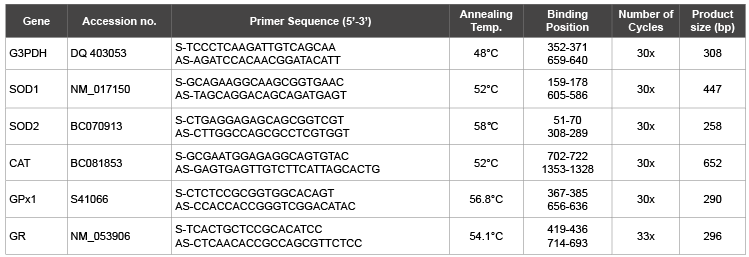
Table 1: Accession number, primer sequence, annealing temperature, binding position, number of PCR cycle and product sizes for amplification of antioxidant genes G3PDH, SOD1, SOD2, CAT, GPx1 and GR
Protein estimation in the samples was done according to the method of Bradford [26] taking BSA as standard.
Quantitation of western blot bands and PCR was done using computer assisted densitometry Image-Quant TL, Image Analysis Software v2003. Relative densities were expressed as the ratio of AOEs band/G3PDH band. Data were expressed as the mean ± SD. The results were statistically analyzed by one-way analysis of variance (ANOVA) followed by Fisher LSD test to find out the level of significance among the mean values. The results were considered statistically significance at a level of p ≤ 0.05.
Body weights of rats of group I, II, III, IV, V and VI were not significantly different from each other at the end of experiment. However, relative organs weights (kidney and liver) of group II, III, IV, V and VI were higher in comparison to group I (sham-operated control). Relative weight of kidney was significantly higher in group III (1.65 fold) in comparison to group II rats. Administration of homeopathic medicine R. serpentina to rats of group IV, V and VI did not bring any significant change in body and organ weights in comparison to group III except for group VI, where relative kidney weight was significantly higher (1.14 fold).
A significant increase in systolic, diastolic, mean blood pressure and heart rate were observed in group III rats as compared to group I and group II rats. Administration of R. serpentina (Q, 30c and 6c) resulted in a significant decrease in the systolic blood pressure (1.15, 1.17, and 1.11 folds, respectively).
The levels of serum sodium (Na+) increased significantly in Group III rats in comparison to group I and group II rats (1.8 and 1.2 folds, respectively). Although administration of homeopathic medicine R. serpentina to rats resulted in a significant decrease of serum sodium level in group V (1.65 fold) and group VI (1.14 fold) rats, and its level remain unchanged in group IV rats as compared to group III rats. Serum potassium (K+) level did not altered in Group III rats in comparison to group I and group II rats. A decrease in K+ level was recorded in group IV (1.35 fold) and group V (1.35 fold) rats but its level was higher in group VI (1.53 fold) as compared to group III rats. Serum calcium level was decreased in group III rats in comparison to group I and group II rats and the decrease was 1.16 and 1.2 folds, respectively. Administration of homeopathic medicine R. serpentina resulted in a significant increase in serum calcium (Ca2+) level in group IV (1.21 fold) and group V (1.19 fold) rats in comparison to group III rats.
Serum level of AST was increased significantly in Group III rats as compared to group I and II rats (1.44 and 1.39 folds, respectively). The same trend was observed in group III rats for LDH (1.86 and 1.95 folds increased, respectively) and ALP activities (1.69 and 1.41 folds increased, respectively) as compared to group I and II rats. AST activity was decreased in response to medicine R. serpentina 30c (1.41 fold), however, LDH and ALP were reduced in response to all the groups receiving the medicine R. serpentina (Q, 30c and 6c) in comparison to DOCA-saltinduced hypertensive rats of group III. For LDH, the decrease was 1.45, 1.68 and 1.51 folds and for ALP it was 1.12, 1.32, 1.37 folds, respectively. A significant reduction in serum ALT level was noticed in group V rats (1.59 fold) in comparison to group III DOCA-salt hypertensive rats.
Serum biochemical profile was not changed significantly in group III rats in comparison to group I and group II animals. Similarly not much variation was noticed in various biochemical parameters of serum of group IV, group V and group VI in comparison to group III rats. However, uric acid was decreased after supplementation of R. serpentina (Q, 30c, 6c) and the decrease was 1.22, 1.25 and 1.46 folds, respectively as compared to group III rats. Creatinine was decreased in group IV (2.12 fold), and glucose was decreased in group VI rats (1.63 fold) as compared to group III. Bilirubin level was decreased in group III rats as compared to group I and group II rats (1.33, 1.26 fold, respectively). After administration of R. serpentina bilirubin was increased in group IV, V and VI rats (1.55, 1.21 and 1.49 folds, respectively) as compared to group III rats.

Table 2: Effect of R. serpentina Q, 30c and 6c potencies on body weight, kidney and liver weight in DOCA-salt induced hypertensive rats.
Group I-Sham-operated control+Normal drinking water; Group II-Nephrectomy+1% NaCl; Group III-DOCA+1% NaCl+Vehicle; Group IV-DOCA+1%
NaCl+Q; Group V-DOCA+1% NaCl+30c; Group VI-DOCA+1% NaCl+6c. Data are expressed as mean ± S.D. of five animals. Data sharing superscripts of
different letters differ significantly along a row at level p ≤ 0.05.

Table 3: Effect of R. serpentina Q, 30c and 6c potencies on systolic blood pressure, diastolic blood pressure, mean blood pressure and heart rate in DOCAsalt
induced hypertensive rats
Group I-Sham-operated control+Normal drinking water; Group II-Nephrectomy+1% NaCl; Group III-DOCA+1% NaCl+Vehicle; Group IV-DOCA+1%
NaCl+Q; Group V-DOCA+1% NaCl+30c; Group VI-DOCA+1% NaCl+6c. Data are expressed as mean ± S.D. of five animals. Data sharing superscripts of
different letters differ significantly along a row at level p ≤ 0.05.

Table 4: Effect of R. serpentina Q, 30c and 6c potencies on serum electrolytes in DOCA-salt induced hypertensive rats.
Group I-Sham-operated control+Normal drinking water; Group II-Nephrectomy+1% NaCl; Group III-DOCA+1% NaCl+Vehicle; Group IV-DOCA+1%
NaCl+Q; Group V-DOCA+1% NaCl+30c; Group VI-DOCA+1% NaCl+6c. Data are expressed as mean ± S.D. of five animals. Data sharing superscripts of
different letters differ significantly along a row at level p ≤ 0.05.
The elevated levels of TBARS in the kidney of hypertensive rats were decreased in the experimental rats receiving R. serpentina (Q, 30c, 6c), and the decrease was 1.37, 1.42 and 1.64 folds in PMF and 1.17, 1.38 and 1.13 folds for MF, respectively, in comparison to group III rats. Administration of R. serpentina also resulted in a decrease in protein carbonyl levels in PMF of group V and VI rats (1.4 and 1.3 folds, respectively) and mitochondrial fraction (MF) of group IV and V rats (1.09 and 1.10 folds, respectively) as compared to group III rats.

Table 5: Effect of R. serpentina Q, 30c and 6c potencies on serum enzymes in DOCA-salt induced hypertensive rats.
Group I-Sham-operated control+Normal drinking water; Group II-Nephrectomy+1% NaCl; Group III-DOCA+1% NaCl+Vehicle; Group IV-DOCA+1%
NaCl+Q; Group V-DOCA+1% NaCl+30c; Group VI-DOCA+1% NaCl+6c. Data are expressed as mean ± S.D. of five animals. Data sharing superscripts of
different letters differ significantly along a row at level p ≤ 0.05.

Table 6: Effect of R. serpentina Q, 30c and 6c potencies on serum biochemical parameters in DOCA-salt induced hypertensive rats.
Group I-Sham-operated control+Normal drinking water; Group II-Nephrectomy+1% NaCl; Group III-DOCA+1% NaCl+Vehicle; Group IV-DOCA+1%
NaCl+Q; Group V-DOCA+1% NaCl+30c; Group VI-DOCA+1% NaCl+6c. Data are expressed as mean ± S.D. of five animals. Data sharing superscripts of
different letters differ significantly along a row at level p ≤ 0.05.
Expression of SOD (Figure 2): DOCA-salt-induced hypertensive rats treated with R. serpentina (Q, 30c, 6c) resulted in a significant increase in SOD1 transcript level (1.83, 1.79 and 1.92 folds, respectively) as compared to group III rats. Decreased translated products of SOD1 in group III rats were further declined significantly in group VI (1.15 fold) i.e. in response to administration of 6c potency of R. serpentina. SOD activity in PMF was decreased significantly in group III rats as compared to group I and group II rats (1.63, 1.58 folds, respectively), which was further increased in group VI rats (1.91 fold) after treatment with R. serpentina 6c. The activity of SOD in MF was declined significantly in group IV, V and VI rats (1.91, 1.91 and 2.36 folds, respectively) in comparison to group III rats. Administration of R. serpentina Q resulted in the decrease of SOD2 transcript level in group IV rats (1.31 fold) and translated products in group V and VI rats (1.31 and 1.36 folds, respectively) as compared to group III rats.
Expression of CAT (Figure 3): The translated products of CAT were decreased in group V and VI (1.31 and 1.30 folds, respectively) as compared to group III rats. Treatment with R. serpentina (Q, 30c, 6c) resulted in the decrease of CAT activity in the PMF of group IV, V and VI rats (1.21, 1.42 and 1.40 folds, respectively) as compared to group III rats, however in MF it was increased in group IV rats (1.13 fold) as compared to group III rats.
Expression of GPx (Figure 4): The transcript levels of GPx1 gene and activity of GPx in PMF were found to be unaltered in DOCA-salt hypertensive rats (group III) and after treatment with R. serpentina. In MF, GPx activity was elevated after treatment with R. serpentina in group V and VI (1.15 and 1.26 folds, respectively) as compared to group III rats.
Expression of GR (Figure 5): The transcript levels of GR gene were increased in group III rats (1.39 fold) as compared to group I rats. However, its level was decreased in group IV, V and VI rats (1.18, 1.27 and 1.17 folds, respectively) as compared to group III rats. GR activity was increased in the PMF of group V and VI (1.21 and 1.16 folds, respectively) as compared to group III rats in response to R. serpentina Q and 6c. Elevated GR activity in MF of group III rats remains unaltered even after treatment with R. serpentina.
Activity of GST (Figure 5): Elevated GST activity in the PMF of kidney of hypertensive rats (group III) as compared to group I rats (control), was further increased in response to the treatment with R. serpentina in Q and 6c potencies (group V and VI) (1.15 and 1.10 folds, respectively). After treatment with R. serpentina, the GST activity in the MF was increased in group IV and VI rats (1.22 and 1.12 folds, respectively) as compared to group III rats.
The DOCA-salt-induced hypertensive rat model is a non-genetic well established hypertension model for studying the effects of different antihypertensive compounds on hypertension [27]. In this study daily oral administration of homeopathic medicine R. serpentina of three potencies (Q, 30c and 6c) had resulted in significant reduction in systolic and diastolic blood pressure parameters. The serum electrolytes such as sodium, potassium and calcium are known to play important role in blood pressure regulation [28].DOCA-salt treated rats absorb sodium (Na+) and water in the kidney, which causes increased circulating blood volume dependent hypertension [29]. Previous studies suggest that intracellular sodium overload and potassium depletion might be important in the pathophysiology of hypertension [30]. In the present experiment, a significant upward trend in the serum sodium levels was observed in the DOCA-salt treated rats in comparison to only unilateral nephrectomizedsalt treated rats. This suggests the induction of hypertension. The reduction of sodium (in group V) and elevation of potassium (in group VI) by homeopathy medicine of R. serpentina suggest that this medicine depending upon its potency may be beneficial for the management of serum electrolytes level in DOCA-salt-induced hypertensive rats. A relationship between serum calcium level and high blood pressure was established by several authors. High consumption of dietary calcium is reported to prevent the rise of blood pressure [31]. A high calcium diet prevents intra myocardial vascular wall thickenings in DOCA-salt and 2-K, 1C hypertensive rats [32]. Our results are in good agreement with the results of Takata et al. [33], where a reduction in serum calcium level was recorded in hypertensive rats. Results of the present study indicate the beneficial role of homeopathy medicine R. serpentina in elevating serum calcium level in hypertensive rats.
Clinical diagnosis of diseases and damages to the structural integrity of the liver is commonly assessed by monitoring the serum AST, LDH, ALP and ALT activities. The increased levels of AST, ALP and LDH in serum suggest that hypertension induced by DOCA might have resulted in liver damage causing the leakage of above enzymes from the liver cells into the blood stream [34]. It is interesting to notice that the three potencies of R. serpentina (Q, 30c and 6c) were capable of protecting liver damages caused due to DOCA-induced hypertension.
It has been found in clinical and epidemiological studies that serum uric acid is related not only to risk of gout, but also to the risk of hypertension, coronary heart disease, and diabetes mellitus [35]. More recently, uric acid has been proposed to have a causal role in hypertension [36]. It has been shown in many experiments that hyperuricemia causes endothelial, arteriolar and tubular interstitial damage in the kidney by increasing oxidative stress and inflammation [37,38]. Administration of medicine, R. serpentina considerably reduced the serum uric acid and creatinine levels in hypertensive rats. This serum uric acid may be a contributing factor to the onset of hypertension in DOCA-salt-induced hypertensive rats [39].
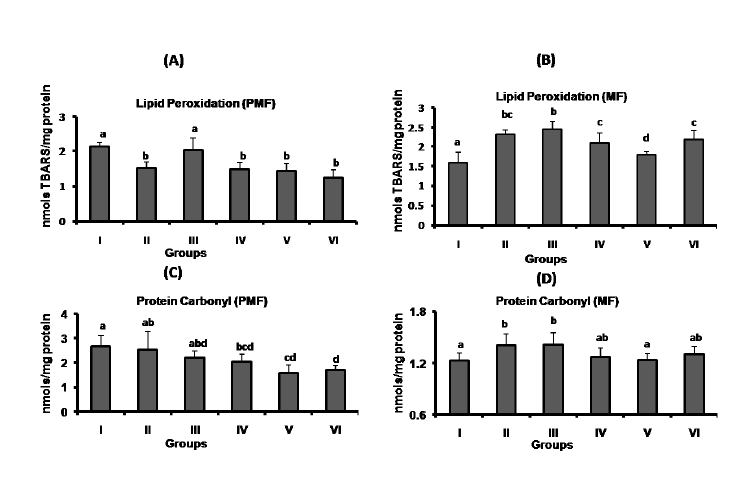
Figure 1: Effect of R. serpentina treatment on LPx and PC in kidneys of different groups of DOCA-salt-induced hypertensive rats. Group I (Sham operated control with normal drinking water), Group II (Nephrectomy with 1% NaCl), Group III (DOCA with 1% NaCl, Vehicle), Group IV (DOCA with 1% NaCl, R. serpentina Q), Group V (DOCA with 1% NaCl, R. serpentina 30c), Group VI (DOCA with 1% NaCl, R. serpentina 6c). Data are expressed as mean ± SD of five animals. Data having different superscripts differ significantly (p ≤ 0.05) from each other.
Bilirubin acts as a potent physiological antioxidant which can protect from coronary artery disease [40]. Serum bilirubin has been consistently shown to be inversely related with cardiovascular disease. Recent studies showed that serum bilirubin is associated with cardiovascular disease related factors such as diabetes, body mass index and metabolic syndrome [41]. Increased serum bilirubin levels in R. serpentina treated groups suggest that the medicine may give additional protection to heart during hypertension state.
Serum glucose level was reduced in hypertensive rats in response to 6c potency of R. serpentina which is similar to the earlier report of Azmi et al. [42]. The authors have reported that methanol extracts of R. serpentina exhibit hypoglycemic activity in alloxan-induced diabetic rat model. Such hypoglycemic effect of 6c potency of R. serpentina might be either due to reduced glucose absorption in intestine or due to augmented uptake of glucose by different tissues from blood.
In this study we have found that the administration of DOCA-salt increases blood pressure parameters which are consistent with the previous studies of Kwak et al. [43] and Chen et al. [44]. ROS are generated as normal products of cellular metabolism. Free radical mediated lipid peroxidation has been implicated in the pathogenesis of many diseases such as cardiovascular diseases, cancer, neurological disorders and aging [45,46]. Increased levels of LPx and PC in the kidney of DOCA-salt treated rats suggest elevated level of oxidative stress in hypertension. It has been reported that hypertension is associated with hyperlipidemia, which promotes lipid peroxidation and enhances oxidative stress [47]. Products of lipid peroxidation such as 4-hydroxynonenal, malondialdehyde etc. binds covalently to amino acid residues of proteins and causes oxidative modification of proteins in kidney [48]. In this study the increased level of lipid peroxidation and protein carbonyl content in the tissue of DOCA-salt hypertensive rats may be due to increased oxidative stress. The reduction in the LPx and protein carbonyl content in uninephrectomized DOCA-salt treated rats after administration of R. serpentina indicates the antioxidative potential of the drug against the hypertension.
Over production or declined elimination of ROS in aerobic cells can lead to their accumulation causing oxidative stress. So all oxygen metabolizing cells have evolved antioxidant defence mechanisms to protect from oxidative damage by the ROS. It has been reported that vascular superoxide formation is enhanced in DOCA-salt hypertensive rats [49] by nicotinamide adenine dinucleotide phosphate (NADPH) oxidase [10]. Long-term administration of superoxide radical scavenger, tempol or NADPH-oxidase inhibitor, apocynin decreased systolic blood pressure and reduced superoxide radical generation in DOCA-salt hypertensive rats [10]. Role of antioxidants in scavenging ROS and protecting the cells from oxidative damage in hypertension condition is well established [50]. Enzymatic antioxidants present in the body include SOD, catalase and glutathione peroxidase, which act as first line of defence against ROS by catalyzing their conversion to less reactive substances [51]. SOD enzyme effectively dismutates highly reactive and toxic superoxide radicals into H2 O2 [50]. Catalase catalyzes harmful hydrogen peroxide molecules and converts it into water and oxygen. On the other hand, GPx catalyzes the reduction of hydrogen peroxide and hydroperoxide molecules to nontoxic products. Our study indicates that different potencies of the drug differentially regulate the expression of antioxidant defence enzymes in activity, transcript and translate levels. The transcript levels of SOD2 were more elevated in hypertensive groups than control, and medicine treatment reduced the mRNA level and activity in the mitochondrial fraction. The same trend was observed for the translated products of SOD2. In contrast, activities of SOD1 exhibited the reverse trend at both transcript and translate levels. These findings may be due to the fact that SOD1 is active in cytoplasm and SOD2 is active in mitochondria and their promoter regions differ greatly between the two enzymes. Our findings are in line with the study of Chaves et al. [52].
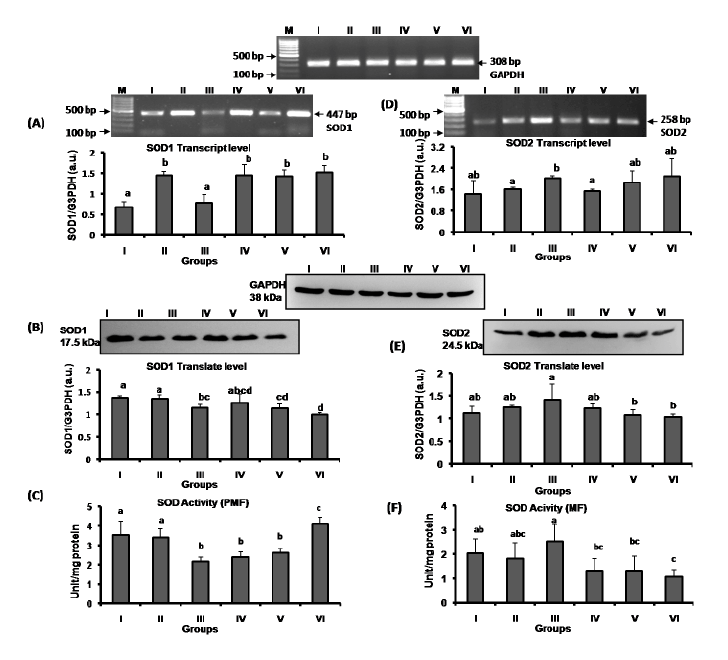
Figure 2: Effect of R. serpentina treatment on expression of renal antioxidant enzyme SOD1 at the level of mRNA (A), translated product (B) and enzyme activity in PMF (C) of control, sham, hypertensive and R. serpentina treated rats and expression of SOD2 at the mRNA level (D), translated product (E) and enzyme activity in MF (F). Group I (Sham operated control with normal drinking water), Group II (Nephrectomy with 1% NaCl), Group III (DOCA with 1% NaCl, Vehicle), Group IV (DOCA with 1% NaCl, R. serpentina Q), Group V (DOCA with 1% NaCl, R. serpentina 30c), Group VI (DOCA with 1% NaCl, R. serpentina 6c). Quantitative representations of SOD1/G3PDH and SOD2/G3PDH of mRNA and proteins obtained by densitometric analyses and expressed as arbitrary units (a.u.). Data are expressed as means ± S.D. of five animals. Data having different superscripts differ significantly (p ≤ 0.05) from each other.
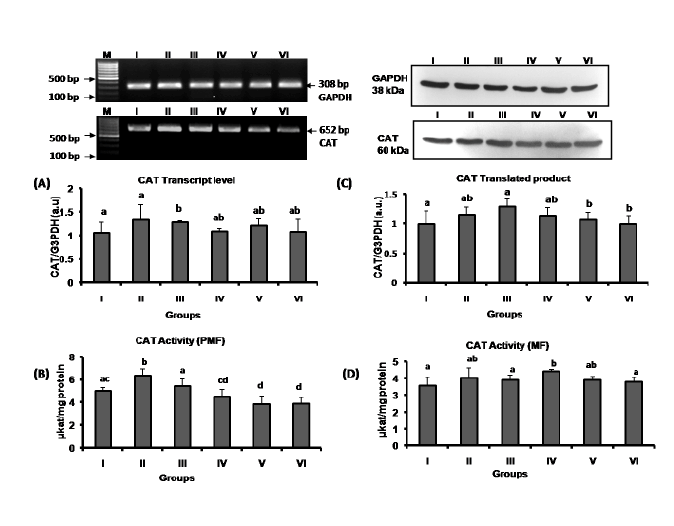
Figure 3: Effect of R. serpentina treatment on expression of renal antioxidant enzyme CAT at the level of mRNA (A), enzyme activity in PMF (B), translated product (C) and enzyme activity in MF (D) of control, sham, hypertensive and R. serpentina treated rats. Group I (Sham operated control with normal drinking water), Group II (Nephrectomy with 1% NaCl), Group III (DOCA with 1% NaCl, Vehicle), Group IV (DOCA with 1% NaCl, R. serpentina Q), Group V (DOCA with 1% NaCl, R. serpentina 30c), Group VI (DOCA with 1% NaCl, R. serpentina 6c). Quantitative representations of CAT/G3PDH of mRNA and proteins obtained by densitometric analyses and expressed as arbitrary units (a.u.). Data are expressed as means ± S.D. of five animals. Data having different superscripts differ significantly (p ≤ 0.05) from each other.
It is a well established fact that mitochondrial respiration is accelerated due to DOCA-salt [53]. Enhancement of cellular respiration is generally associated with increased production of superoxide radicals at the site of ubiquinone [53]. Our results suggest that the alteration of antioxidant enzymes in response to R. serpentina treatment to DOCA-salt treated rats is modulated through distinct regulatory pathways. R. serpentina protect the rat kidney against oxidative stress induced by DOCA-salt hypertension. However, different potencies of R. serpentina differently exhibit their effects on oxidative stress parameters and antioxidant defence system in hypertensive rats.
Overall findings of our study indicate that administration of R. serpentina (Q, 30c and 6c) reduces blood pressure, as evident from reduced blood pressure in hypertensive rats. We, for the first time observed that homeopathic medicine R. serpentina (Q, 30c and 6c) can decrease hypertension effectively and Q potency was the most effective in the regulation of blood pressure. It has not shown any drug toxic effect on the organs, which is evidenced by the serum biochemical parameters. R. serpentina also exhibited antioxidant potential in this study as it could attenuate oxidative stress indices in the kidney of DOCA-saltindused hypertensive rats. Thus R. serpentina has both antihypertensive and antioxidant properties, as evident from considerable decrease in the blood pressure, oxidative stress parameters and modulation of enzymatic antioxidants in response to drug treatment. These results provide an important pharmacological basis for the use of this homeopathically prepared medicine to prevent the hypertension and associated oxidative stress.
The work was generously funded under Extra Mural Research project of Central Council for Research in Homeopathy by Department of AYUSH, Ministry of Health and Family Welfare, Govt. of India, New Delhi (F. No. 23-94/2006-07/CCRH. Tech/EMR/1330. Dt. 10.01.2008). We are highly thankful to the Principal, Dr. A.C.H. Medical College and Hospital, Bhubaneswar, India and to the Head, Post Graduate Department of Biotechnology, Utkal University, Bhubaneswar, India to allow for conducting the study and for providing laboratory facility. Authors also acknowledge the support of DST-PUSRE grant (Gov. of India) to the Department of Biotechnology, Utkal University, Bhubaneswar.
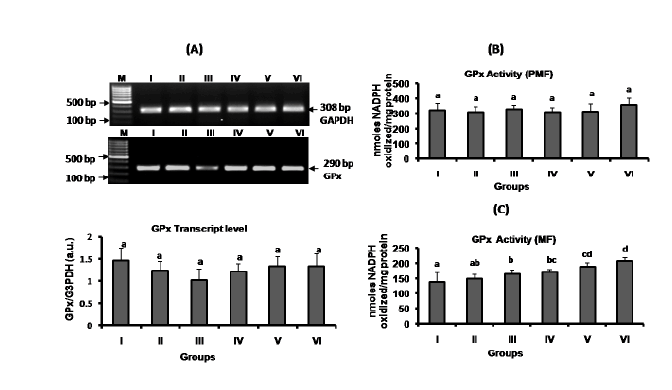
Figure 4: Effect of R. serpentina treatment on expression of renal antioxidant enzyme GPx at the level of mRNA (A), enzyme activity in PMF (B), and enzyme activity in MF (C) of control, sham, hypertensive and R. serpentina treated rats. Group I (Sham operated control with normal drinking water), Group II (Nephrectomy with 1% NaCl), Group III (DOCA with 1% NaCl, Vehicle), Group IV (DOCA with 1%NaCl, R. serpentina Q), Group V (DOCA with 1% NaCl, R. serpentina 30c), Group VI (DOCA with 1% NaCl, R. serpentina 6c). Quantitative representations of GPx/G3PDH of mRNA obtained by densitometric analyses and expressed as arbitrary units (a.u.). Data are expressed as means ± S.D. of five animals. Data having different superscripts differ significantly (p ≤ 0.05) from each other.
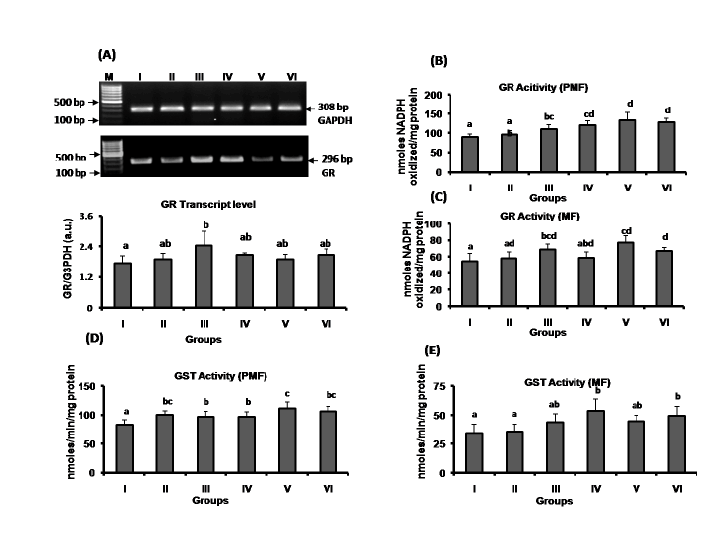
Figure 5: Effect of R. serpentina treatment on expression of renal antioxidant enzyme GR at the level of mRNA (A), enzyme activity in PMF (B), and enzyme activity in MF (C); GST enzyme activity in PMF (D) and MF (E) of control, sham, hypertensive and R. serpentina treated rats. Group I (Sham operated control with normal drinking water), Group II (Nephrectomy with 1% NaCl), Group III (DOCA with 1% NaCl, Vehicle), Group IV (DOCA with 1% NaCl, R. serpentina Q), Group V (DOCA with 1% NaCl, R. serpentina 30c), Group VI (DOCA with 1% NaCl, R. serpentina 6c). Quantitative representations of GR/G3PDH of mRNA obtained by densitometric analyses and expressed as arbitrary units (a.u.). Data are expressed as means ± S.D. of five animals. Data having different superscripts differ significantly (p ≤ 0.05) from each other.
Download Provisional PDF Here
Article Type: Research Article
Citation: Kumar S, Dandapat J, Chainy GBN, Hati AK, Nanda L, et al. (2016) Homeopathic Medicine Rauwolfia Serpentina Ameliorate Blood Pressure and Oxidative Stress Parameters of Kidney by Modulating Expression of Antioxidant Enzymes in Deoxycorticosterone Acetate (DOCA)-Salt-Induced Hypertensive Rat Model. J Drug Res Dev 2(1): http://dx.doi.org/10.16966/2470-1009.111
Copyright: © 2016 Kumar S, et al. This is an open-access article distributed under the terms of the Creative Commons Attribution License, which permits unrestricted use, distribution, and reproduction in any medium, provided the original author and source are credited.
Publication history:
All Sci Forschen Journals are Open Access